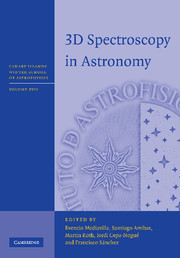Book contents
- Frontmatter
- Contents
- List of contributors
- List of participants
- Preface
- Acknowledgements
- List of abbreviations
- 1 Introductory review and technical approaches
- 2 Observational procedures and data reduction
- 3 3D spectroscopic instrumentation
- 4 Analysis of 3D data
- 5 Science motivation for integral field spectroscopy and Galactic studies
- 6 Extragalactic studies and future integral field spectroscopy science
- 7 Tutorials: How to handle 3D spectroscopy data
4 - Analysis of 3D data
Published online by Cambridge University Press: 06 August 2010
- Frontmatter
- Contents
- List of contributors
- List of participants
- Preface
- Acknowledgements
- List of abbreviations
- 1 Introductory review and technical approaches
- 2 Observational procedures and data reduction
- 3 3D spectroscopic instrumentation
- 4 Analysis of 3D data
- 5 Science motivation for integral field spectroscopy and Galactic studies
- 6 Extragalactic studies and future integral field spectroscopy science
- 7 Tutorials: How to handle 3D spectroscopy data
Summary
Introduction
Presentation and scope
This chapter contains the proceedings of the course on analysis of 3D spectrographic data given as part of the XVII Canary Island Winter School of Astrophysics. It provides an overview of some basic and generic analysis techniques for 3D spectrographic data.
It includes a description of an arbitrary selection of tasks with, whenever possible, examples on real data and a lot of discussion about noise and errors. To illustrate the examples, we will make a heavy use of tools that are part of the XOasis software developed at the Centre de Recherche Astrophysique de Lyon (CRAL) and of 3D datasets obtained using the TIGER and OASIS instruments.
This course is not limited to pure 3D analysis techniques as the core of the analysis of 3D datasets is either identical or similar to what is done for regular spectrographic data.
It has some obvious caveats and limitations:
It is not exhaustive but contains a rather arbitrary selection of tasks and tools that we have considered as unavoidable.
The methods and examples are biased toward extragalactic astronomy.
It is limited to the data analysis techniques used in visible and near-infrared (NIR) astronomy.
It does not address those used in the radio and X-ray communities (long-time users of 3D spectrography).
Data analysis
Before starting, we need to define better what data analysis is and, in particular, where it starts and stops in the process leading from raw data to ready-to-publish information (see Figure 4.1).
- Type
- Chapter
- Information
- 3D Spectroscopy in Astronomy , pp. 126 - 157Publisher: Cambridge University PressPrint publication year: 2010
- 1
- Cited by

